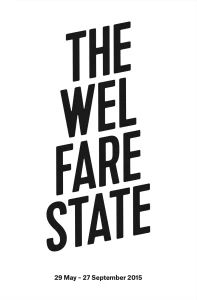The Welfare State Is Not a Thing of the Past

Overview of the first room with posters from four Flemish archives, 'The Welfare State' exhibition, M HKA. Photo by Christine Clinckx, M HKA.
The welfare state gives form to the values of freedom, justice and love of one's neighbour in a secularised society. In this sense, the welfare state is not merely a social system or an institution, but just as much an ethics.
–Herman Deleeck, 19921
One of the delights of thinking about the welfare state, but also one of the difficulties, is that it is the object of so much intellectual and political passion, so much controversy and affection. It is in the nature of the welfare state that it concerns everyone, not least a public museum of contemporary art that would not exist without it. We who worked on this project agreed from the beginning that it should not become nostalgic. The welfare state, we concurred should not be equated with a sentimental longing for the past when the future is something to look forward to.
The Welfare State exhibition at M HKA is therefore not set up to celebrate an idealised memory of post-War prosperity. Belgium's verzorgingsstaat or État-providence was, in its classical incarnation, a centralised 'caregiving' state, but when federalisation began in the early 1970s, it resonated with the politics of the time. France's trente glorieuses – 'thirty glorious' years following the Second World War – saw high economic growth and expansive state policy, but also brutal colonial wars and near-revolutionary social unrest. The record-breaking annual economic growth of Sweden's rekordåren in the late 1960s and early 70s could not be sustained once the oil crisis of 1973 made critical self-reflection necessary.2
It is tempting, seventy years after the end of the Second World War, after Year Zero,3 to lament the loss of that certainty with which every new generation was able to say "Most of our people have never had it so good".4 But let us not forget that the welfare state, as a system of thought and a monument to pragmatic progressive politics, is a work in progress, a field of innovation through trial and error. Let us, indeed, remember that want, disease, ignorance, squalor and idleness – the "five giant evils"5 – have yet to be vanquished.
If, in this sense, the welfare state is a thing of the future, it remains very much of the moment, and not only in our part of Western Europe. Like many developed economies, Flanders and Belgium (and of course, also Brussels and Wallonia) are now struggling to adapt the agreements and institutions of the welfare state to the new normalcy of an economy growing by less than two per cent a year, among many game-changing facts and figures at home and abroad.
No, the welfare state is not a thing of the past. Nor is it in life-threatening danger; nor, necessarily, in decline. Yet it is not static and cannot afford to be. Just before I sat down to write this, I listened to a programme on Swedish Radio about 'hofficing': inviting strangers to use your home as a shared office, a new practice within the broader phenomenon known as the 'social economy' or 'collaborative economy'.
Might this trend among networked individuals be relevant to our exhibition? Possibly. Indeed, probably. And not least because of how employment security and the tax base will be affected in the long term should more and more people choose to bypass the formalised economy. Such societal experiments may eventually tilt the precarious balance inside the complex system that the Danish sociologist Gøsta Esping-Andersen calls the "welfare regime".6 At the same time, this regime knows very well that it must be open to new ideas if it wants to stay in power.
The welfare state is not 'owned' by any single ideology or country. The US is still waging its War on Poverty, announced by Lyndon B. Johnson half a century ago, alongside the more talked-about War on Drugs and War on Terror. China and Indonesia are introducing universal health insurance for their vast populations. The Soviet Union and the Socialist Bloc offered social services comparable to those at schools, universities and hospitals in the global West, on terms that were not entirely bad for the population; even today, Cuban health care has quite a reputation. Across Western Europe, all political movements on the respectable left-to-right spectrum co-authored the non-violent, consensual and incremental politics and the 'mixed economy' that allowed the continent to recover from the devastation of war and the loss of empire in the mid-twentieth century.
Growing up in Sweden in the 1970s – my own experience – meant being indoctrinated in the official truth that the technocratic, one-size-fits-all welfare state was unthinkable without the ever-victorious Social Democratic Workers' Party. The Swedish ruling class at the time would have reacted with sincere perplexity had anyone suggested that the Catholics of continental Europe were also offering progressive and morally sound social policy. (No one ever did, of course.) So to me, the full title of Herman Deleeck's now classic textbook on the Belgian welfare state is charmingly exotic and baroque: The Architecture of the Welfare State, or a Description of the Principles, the Facts and the Problems of This Society, Wherein the Connection Is Made between Welfare, Employment, Inflation, the Labour Force, Its Aging, Social Dialogue, Taxation, Government Social Expenditure, Social Policy, the Division of Income; Whereby Crisis and Critique Are Not Shunned, but Whereby It Is Also Posited That This Welfare State Is an Incomparably Advanced Form of Society Based on Freedom and Solidarity, the Spiritual Ideal of Europe.7
Deleeck was a Flemish economist, jurist and top politician for the Christian People's Party (which was rebranded in 2001, and is now called CD&V, short for Christian Democrat and Flemish). He spotted a paradox within the post-War Western European welfare state, which he named the Matthew Effect, after Matthew 13:12: "For whosoever hath, to him shall be given, and he shall have more abundance: but whosoever hath not, from him shall be taken away even that he hath." The welfare state was originally built on a morally motivated rejection of charity, as well as, at least implicitly, of traditional patriarchal society rooted in familial networks. Certain benefits should, it declared, be offered to all citizens, regardless of their income or wealth; individuals in need should not be humiliated by having to ask for help, even from their own relatives.
Since the early-to-mid 1970s – the waning days of the post-War period of high economic growth and low social inequality (at least compared to now, if we are to believe Thomas Piketty's calculations in his 2013 book, Capital in the Twenty-First Century) – the European welfare state has, in fact, been in an almost constant condition of crisis and reinvention. It has been criticised, by all ideological camps, for being either lacking or exceeding in ambition or efficiency, for going too far or not far enough.
Deleeck problematised some outcomes of the entitlements system from his perspective of "compassionate conservatism". In a recent book,8 two senior editors of the liberal, pro-globalisation weekly The Economist bring up – disapprovingly and no less than three times – the free bus passes that Sir Mick Jagger and Sir Elton John are entitled to as senior British citizens. The authors report on what they see as constructive approaches to making the welfare state more efficient, in places as different as Stockholm, Singapore and Sacramento, the state capital of California.
Meanwhile, left-leaning debaters and activists continue to argue against cuts in public spending and, crucially, the priorities they are based on as well as the vision of a future society they reflect. A recent example in this country is the Hart boven Hard, or 'Heart over Hard', movement, which came together in August 2014 to protest against budget cuts by the new Flemish and Belgian governments. Together with its Walloon sister organisation, Tout autre chose, meaning 'Something Entirely Different', it organised a march in Brussels on 29 March that drew some 20,000 protesters.
#Can the Welfare State Be an Exhibition?
The relation between art and politics is not a passage from fiction to reality but a relation between two ways of producing fictions.
–Jacques Rancière, 20109
The welfare state has, generally speaking, become synonymous with the synthesis of a market economy and active government that characterises both 'Western' and 'emergent' societies today. The term itself can no longer be reserved only for countries such as Belgium or New Zealand, the US or Japan; it also describes how countries as different as Brazil, Turkey, South Korea and China treat their populations. Yet there is little agreement among the many who operate and observe public social policy – politicians, civil servants, trade union leaders, social scientists, journalists, the public at large – about how the welfare state could or should be defined in more precise terms. What is part of it and what is not?
For The Welfare State exhibition, Ghislaine Peeters, Head of Production at M HKA, and I initiated a collaboration with the professors and doctoral students of the Herman Deleeck Centre for Social Policy at the University of Antwerp. Together with Professor Ive Marx, we have organised a series of seminars involving the centre's researchers and the artists invited to participate in the exhibition. The first of these, which took place at the university on 9 April 2015, featured Professor Marx and the artist Kajsa Dahlberg, who spoke on precarious labour and how it can be objectively observed and evaluated.
An interesting sub-theme emerged in this debate: should the work of an artist and the financial support that she receives from the state be seen as part of the welfare state? For both museum curators and artists the answer must be yes. Otherwise, why would we make this exhibition? We find it self-evident that the ambition to provide efficient and sophisticated public education, and ultimately universal access to knowledge and culture, is a key component of the welfare state.10 Those who produce and mediate and appreciate culture and art do so as members of society. They – we – may be in opposition to society, or at least take a dissident position towards it. But this does not mean that cultural activities should be regarded as separate from a 'useful' mainstream economy. Our hosts, the professors and doctoral students, took a more cautious view. They pointed out that some researchers do not consider public subsidies for culture an integral part of the welfare state, but prefer a narrower definition of the term, focussing on social policy in a stricter sense: taxation, transfers, labour market regulations and other such tangible aspects of social engineering.
What makes this collaboration with the university so important, at least to us, is precisely this difference in perspective and method. Whereas we – the 'we' of the art world – maintain that we must always be at liberty to interpret any phenomenon or idea in any meaningful way, this subjective approach ceases to be productive in the realm of academic research. Creativity can be just as important in academia as in art, but a researcher who slips up on terminological consensus will soon be outmanoeuvred.
The next seminar, on 11 May at the University, featuring the doctoral candidate Sarah Marchal and the artist Francisco Camacho Herrera, asked to what extent the welfare state can be seen as an emancipatory project. Interestingly, while this is a more speculative question than that of how precarious labour might be represented, it was suggested by the university rather than the museum.
A question that this series of discursive enlargements of the exhibition will try to answer ahead is: Does the welfare state have a form? Our discussions at the Herman Deleeck Centre started with the idea that the welfare state is a closed system, designed to cater to those on the inside, and to keep others out; therefore it cannot be said to have an open form. But it is difficult for us within the museum to avoid raising follow-up questions: If the welfare state does have a form, can it be shown? Can the welfare state be an exhibition? And if it can, what kind of exhibition?
A museum of contemporary art must always respect some fundamental and specific freedoms that define art and, arguably, make it useful to society: the freedom of movement between disciplines and topics and means of expression; the freedom of conscience that allows art to challenge aesthetic, ethical and political prohibitions; and, perhaps most importantly, the freedom from the ban on self-contradiction that underpins Western philosophy and science.
An exhibition called 'The Welfare State' and built around the work of eight contemporary artists may disappoint viewers who believe they are going to see an exhibition about the welfare state with contributions by these eight artists. That is a risk we are running.
It would be presumptuous to claim that this exhibition has all the right answers to the many questions about the relationship between art and politics. Yet, its composition (based in the subjective interests of the participating artists) and its organisation (originating in the intention to restrain curatorial subjectivity and seek truly collaborative relations with various partners) betray the same crucial ambition: to create an event that speaks in different voices but also comes together as a song because it does not submit to a single master narrative.
The participating artists are well versed in various practices of political activism and its mediation throughout cultural life. But as I see it, they have chosen to apply their ideas and convictions in unpredictable ways, remaining committed to constantly observing the outside world in all its imperfections and to interacting with fellow human beings. They have chosen to respond to and transform reality through aesthetic means.
The possibility to do this, and to do it well, is what the philosopher Jacques Rancière is defending with his notion of the "aesthetic regime" as developed in his two relatively recent books, The Emancipated Spectator, from 2008, and Aisthesis, from 2011.11 Rancière's refutation of the "oppositions between the collective and the individual, the image and live reality, activity and passivity, being in charge of oneself and alienation"12 is all the more convincing for resounding from within an intellectual practice that speaks clearly and passionately about emancipation. Moreover, Rancière sees emancipation as dependent on the distance between people that is "the normal condition of all communication".13 "The 'politics of art' thus appears in the interlacing of three logics: that of the forms of aesthetic experience, that of the work of fiction and that of meta-political strategies. This also implies a curious and contradictory weaving-together of the three forms of efficiency that I have tried to define: the representative logic that wants to produce effects through representations, the aesthetic logic that produces effects through the suspension of representative ends and the ethical logic that wants the forms of art and those of politics to identify directly with one another."14
Rancière's take on art is certainly not apolitical, and he does not argue for a revival of the nineteenth-century slogan l'art pour l'art. His argument is, rather, that the contradiction between passive spectatorship and active or critical engagement is a construction that leads us astray. This has been a guiding light for our exhibition.
Esping-Andersen's welfare regime and Rancière's aesthetic regime may even have something in common. Are they not more radical, in the long run, than other, more revolutionary alternatives, precisely because they are both based on respect for the distance – and difference – between people that makes dialogical communication possible? And is this fundamental possibility of communication not what unites such different social phenomena as the negotiation between organised interests (in the labour market, for instance) and confidence in highly subjective statements (in the arts)?
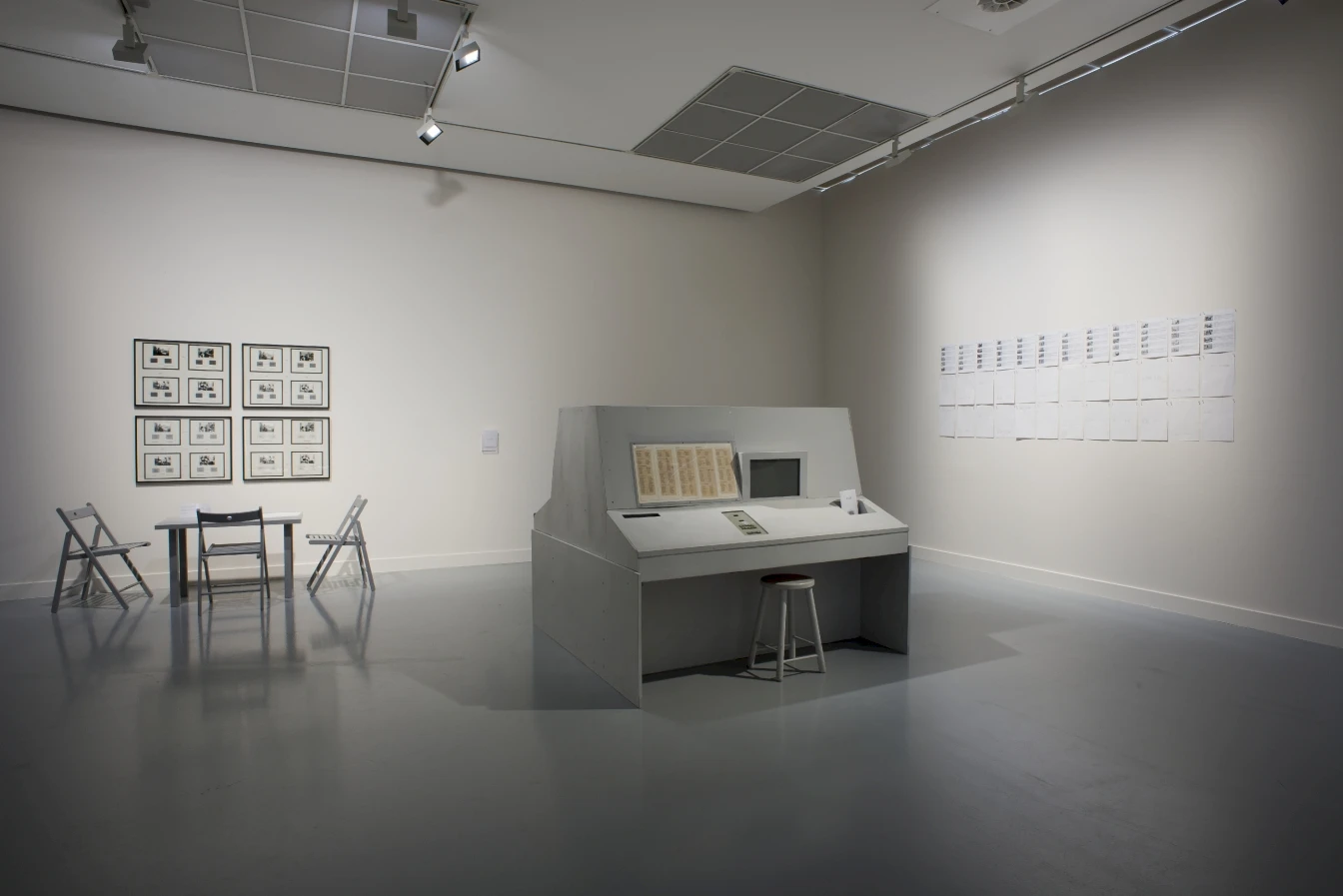
Stephen Willats, Meta Filter (1973--75) and A State of Agreement (1975). 'The Welfare State' exhibition, M HKA. Photo by Christine Clinckx, M HKA.
All eight artists in The Welfare State have set up their own aesthetic regimes over the course of their careers, whether they span more than half a century, in the case of Stephen Willats, or just around one decade, as with the youngest participants, Francisco Camacho Herrera and Donna Kukama. It is all but impossible to characterise these regimes in just a few short sentences. The issue here is whether the title of this exhibition is justified by the practices and works it presents; in the inverse, it is whether the inclusion of these artists is justified for an exhibition with this title.
The term cybernetics is used much less often today than in the post-War decades, although this science of communications and automatic control systems in both machines and living things started to really dominate our lives only in the digital age. In the early 1970s, Stephen Willats's interest in cybernetics shifted from the live interaction between his sculptural works and their viewers to his own live interaction with people living in various socio-economic conditions. The encounters were transformed into diagrammatic image-text compositions, combining photographs, quotes from conversations and graphic symbols. This exhibition includes a selection of his works from the last forty years that is as generous as the available space allows.
One of the things that makes Willats's oeuvre truly remarkable is the quality of the relations he builds with people through his work. He does not instrumentalise them. Instead, he encourages all those participating in the work as protagonists or as viewers – sometimes one in the same – to take each other into account, to come to terms with one another. This is particularly true of Meta Filter, from 1973–75, a work that is both sculpture and event, both process and its documentation. It allows two participants to sustain a dialogical negotiation in real time, through a computer encased in a rather large wooden console, and to simultaneously produce a record of it by filling out a 'Problem Book'. The hardware was advanced technology forty years ago; the experience it makes possible is still a cutting-edge enactment of social thought.
Anne-Mie Van Kerckhoven says that her work has always been about the welfare state, not least in the sense of 'inner welfare'. As a samenlevingsform – the Dutch term denoting 'form of society' also connotes 'ways of living together' – the welfare state produces artificial ideas of comfort, at the same time as it offers useful guidelines for how to survive contemporary reality. In this sense, the welfare state determines and envelops Van Kerckhoven's visual universe, where contorted human (mostly female) figures move across distorted (mostly interior) spaces. The scientific community's quest for artificial intelligence, the as-yet-elusive ultimate goal of cybernetics, has provided her with inspiration and advanced working tools for more than thirty years. To this exhibition she contributes what might be called a 'freeform ensemble' of new and existing works, including paintings, digital prints and one of her mobile 'carrel' installations, doubling as a workspace and a surface for images. The presentation allows viewers to glean her non-linear and ultra-logical thinking, and to catch a brief glimpse of Head Nurse, a nurturing but also life-threatening presence that can be felt throughout her oeuvre.
Although best known for his wryly humorous and subtly obsessive and humorous films starring characters mostly played by his closest family and friends, Josef Dabernig is in essence a spatial artist. The films should really be seen in the architecture he designs for them, and this exhibition allows visitors to do so. Dabernig is inexorably drawn to the remains of the welfare regime established by 'real existing socialism'. It is as if he cannot get enough of the settings provided by train compartments, holiday resorts and sports bars in countries that continue to be, 25 years after the fall of the Iron Curtain, an exotic 'near-abroad' to the Viennese. Dabernig's eye is often trained on the 'restorative' activities that citizens of the welfare state are encouraged to engage in. Two films are shown here: one about exercising, the other about holidaying.
Artūras Raila's two works in the exhibition deconstruct ideological speech simply by letting it flow, so that viewers do the analytical work themselves, almost without noticing. Some fifteen years ago, Raila visited Austria just before the election that brought the right-wing Austrian Freedom Party to power. He showed his video footage from the trip to the leadership of the outlawed right-wing National Democratic Party in northwest Lithuania and made another video with their comments, which are all the more ideological for being spontaneous and expressing the world view (and complexes) of 'simple people' in the periphery of the periphery. A few years ago, Raila visited Copenhagen and chanced upon the funeral of one of Denmark's wealthiest philanthropists, Mærsk Mc-Kinney Møller. His 'libretto' – a wall-text and series of animated films – based on his spiritual encounter with the deceased becomes an opera of authority and activism, deference and dissent. One of the characters says: "He should have paid his taxes instead."

Anne-Mie Van Kerckhoven's room, 'The Welfare State' exhibition, M HKA. Photo by Christine Clinckx, M HKA.
One reminder of the closed form of the welfare state is Europe's less than adequate response to the humanitarian disaster caused by the civil war in Syria. The 'others' must be kept out, at almost any cost. Róza El-Hassan proposes a solution to the housing problem caused by the large number of displaced persons within Syria and refugees in neighbouring countries: build shelters using adobe bricks, the cheapest local material, based on the traditional beehive-shaped houses of northern Syria; the domed constructions do not need to be insulated in winter and they keep cool in summer. Erected in the exhibition as a sculptural installation (and as a large painting, because they will also be adorned with a representation of the starry sky), this structure and another model for a simple dwelling, the one-room adobe 'cube' common in the Egyptian countryside, additionally offer functional prototypes for emergency housing that can be mass-produced with support from the NGO sector.
If we had to list the most important contributions art can make to society at large, self-reflection would probably come out on top. Kajsa Dahlberg has wired self-reflection through her entire practice. The medium she chooses to work with – in the case of The Welfare State, documentary cinema – becomes part of the mental and technical substance of her work, in the working process and the results it yields. Here, the chosen topic is labour, specifically precarious labour. Dahlberg's narrative incorporates not only the self-reflection of everyone who contributed to her project (including the factory workers who made her equipment, the delivery men on tight daily schedules and the self-employed translator of the subtitles) but also a history of labour specific to cinema, notably the importance of film footage to the development of Methods-Time Measurement, which regulates factory labour. Today the system is increasingly used in the service sector, sometimes even to measure the productivity of creative professionals.
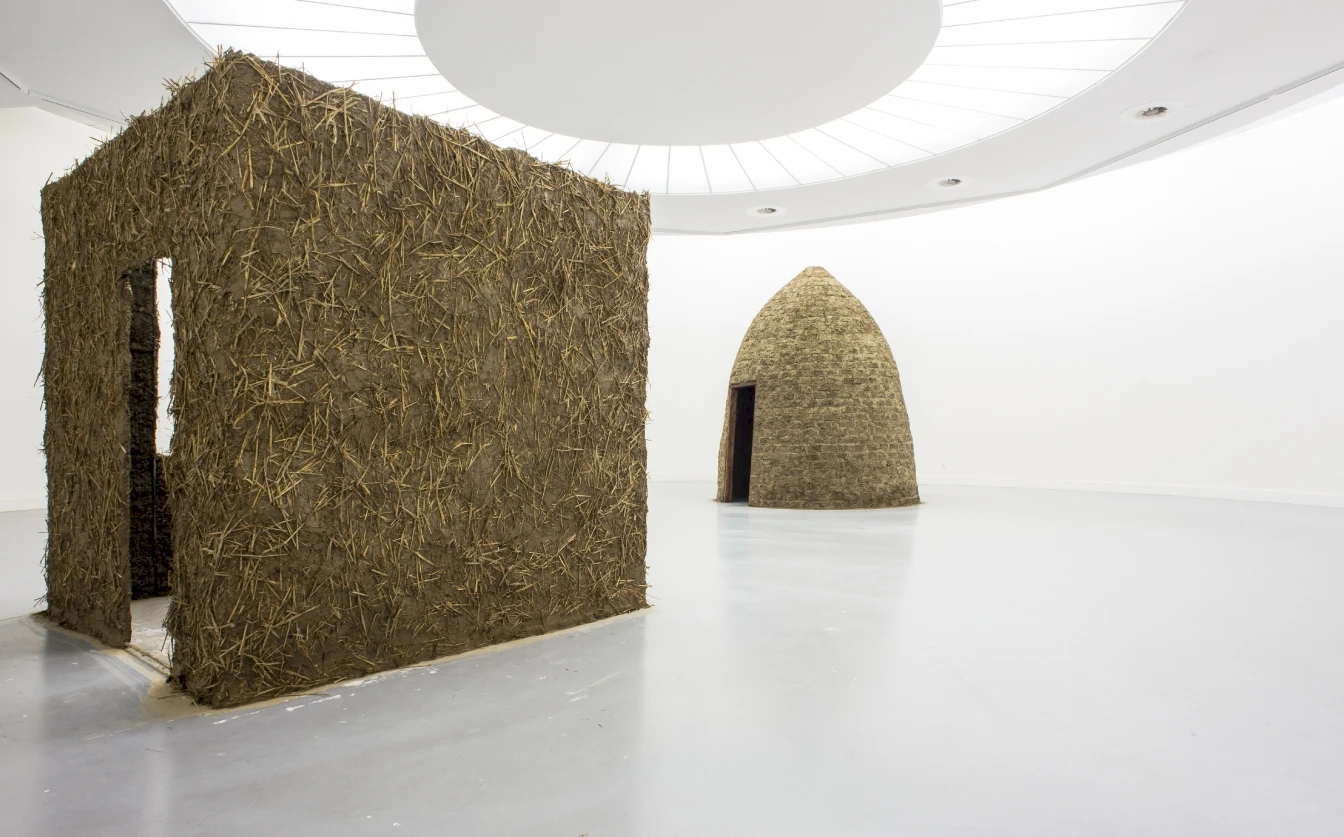
Róza El-Hassan, Breeze 9 (Natural Air Conditioning and Adobe Houses), 2015. 'The Welfare State' exhibition, M HKA. Photo by Christine Clinckx, M HKA.
The distance from labour to desire is not as long as we might think. Francisco Camacho Herrera's contribution to this exhibition is an unambiguously process-oriented work: a website owned and managed by users who wish to work together in real terms. While the tools for initiating and sustaining such collaboration are virtual (a venue for posting projects online and a system of points reflecting the amount of working hours invested), the projected outcome is not. Camacho Herrera was inspired by the utopian communitarianism that Charles Fourier called for in the early nineteenth century. He intends fulltopia.com to articulate a collective desire to bypass the monetary economy and to facilitate the exchange of services for other services. Throughout the duration of the exhibition, the website will be tested by actual, already-existing communities, such as jobseekers and volunteer networks.
Donna Kukama uses performance to highlight tensions and movements in contemporary society. She performs in public spaces – streets and squares and shopping malls populated by real people – injecting strong doses of the imaginary into the transactions of the everyday; she creates the half-real. As an artist, Kukama is both pronouncedly visual and profoundly socio-political. She might, for example, appear in contexts where high art is largely unknown, to then incorporate references to the history of Western painting. Her unsettling repurposing of existing institutions – whether financial, real estate or civic – aims directly at the fundaments of the prevailing order. She precariously balances between the theatrical and the socially engaged, between the solidarity of the political activist and the non-alignment of the artist. Subversion can only ever happen on the inside of a system powerful enough to call for resistance.
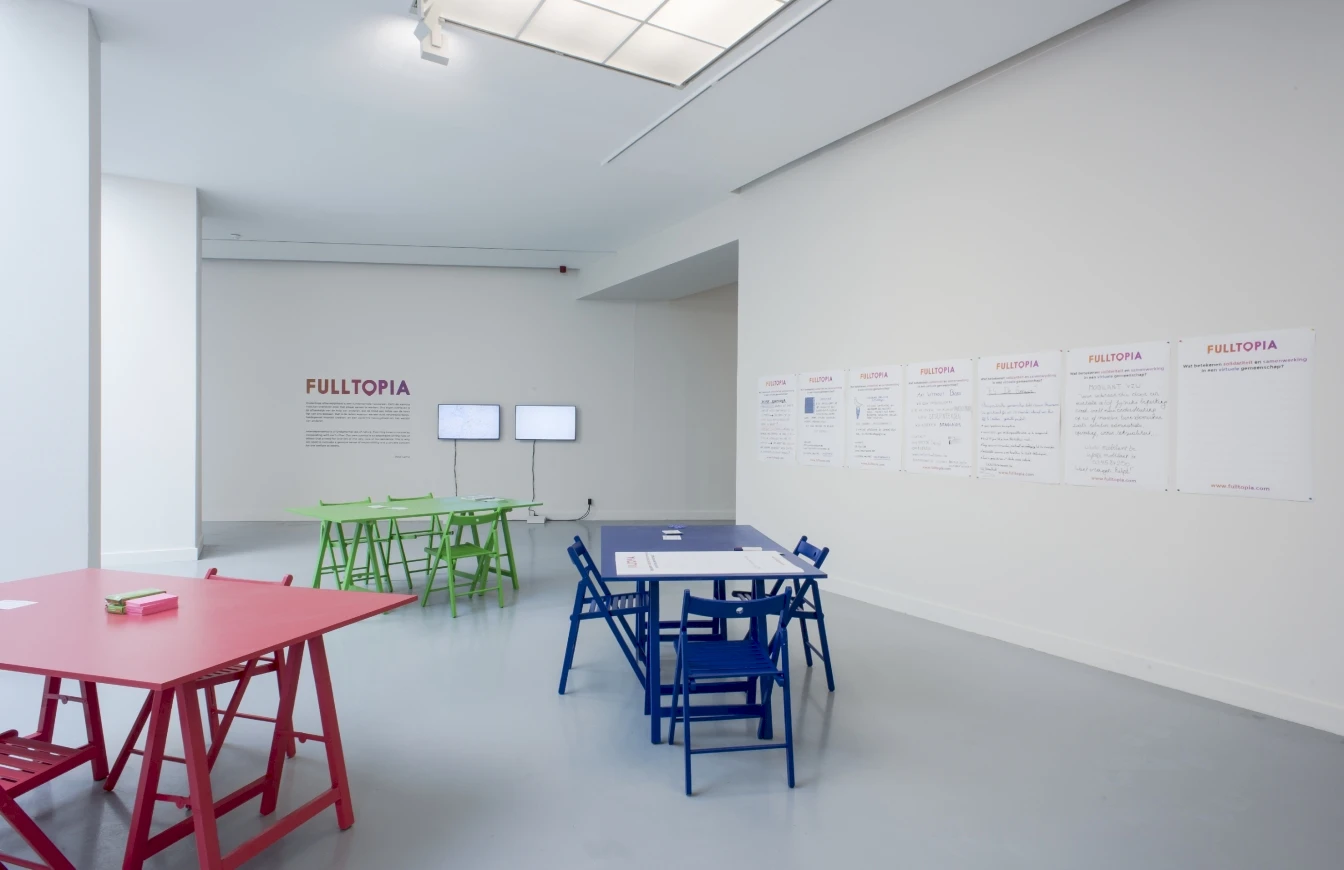
Francisco Camacho Herrera, Fulltopia (2015-ongoing). 'The Welfare State' exhibition. Photo by Christine Clinckx, M HKA.
#Is the Welfare State the Antithesis of Art?
Art is the societal antithesis to society, not to be directly deduced from it.
–Theodor W. Adorno, 197015
The welfare state in its classical Western incarnation embodies the ideal that everyone is equal before the law and that the same rules apply to all. But the welfare state also developed out of the professionalised administrative apparatus set up in the eighteenth and nineteenth centuries in the nation states of a rapidly industrialising Europe and in its colonial dependencies overseas. Modern rules-based bureaucracy replaced earlier personalised systems of governance inherited from the princely states of the Middle Ages. In the newly unified Germany of the 1870s, the 'Iron Chancellor', Otto von Bismarck, put in place the first modern welfare regime, complete with health insurance and public education, to counter the influence of the socialists among the growing working class.
The European welfare state was at least partly an anti-revolutionary project of the old establishment, and to this day it operates with regulations that must be applied to every individual in the same way. While it may protect individual rights and freedoms, the welfare state demands something in return: individuals must identify themselves as members of society first and foremost. That, incidentally, is a price that few artists are prepared to pay in full. Although many artists and intellectuals are ardent supporters of the welfare state in both theory and practice, and although they may be fascinated by rules as such, they are not generally known for their readiness to submit to rules formulated by others.
This has proven an interesting complication in organising this exhibition, The Welfare State, in a museum of contemporary art. It is not advisable to ask artists of this calibre to help illustrate the meaning of an exhibition's title. Not that illustration is bad in and of itself: its origins lie in illumination, namely "casting light upon something". It has, however, become embarrassingly associated with a practice of redundancy: of retelling something in images that has already been told in words (as too many book illustrations do) or vice versa (as is too often the case with press releases for art exhibitions).
Is the welfare state the antithesis of art? I find it pertinent to rephrase Adorno's statement into this question, even if I am not prepared to answer yes. I have, however, included 'non-art' in the exhibition, as a way to elucidate what the welfare state means to a Belgian audience and to anchor the cumulative narrative of the exhibition in this country's interestingly complex and contested political history. There is, of course, nothing new about using visual evidence of things happening in society in the hope of painting a true picture of social reality. "A visitor to the Paris Universal Exhibition in 1900 searched hard to find its most explosive exhibit. [...] In the open air, officialdom celebrated 'The Triumph of Industry and Empire', but tucked away on a side street were cramped rooms devoted to reckoning the human issues raised by this triumph. The fair's organisers dubbed the side-space a musée social, a social museum, a Louvre of labour meant to show how capitalism gets its work done. The exhibitors described their rooms quite differently, naming the space La Question sociale – 'The Social Question'. [...] The statements made in the Paris rooms came mostly in the form of documents and maps tacked up on the walls."16
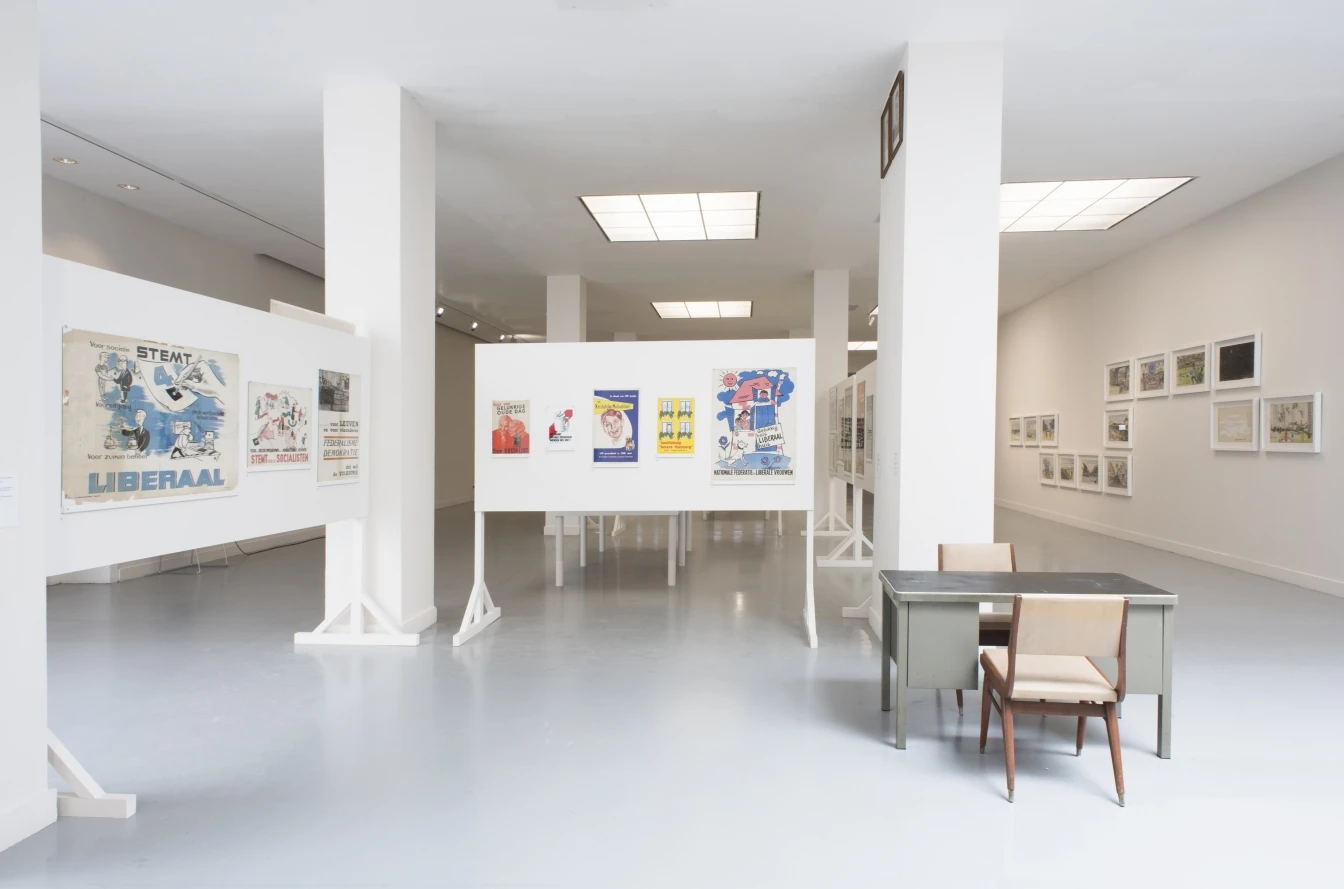
Overview of the first room with posters from four Flemish archives, Renaat Braem's series of drawings History of the Emergence of Deurne (1963) and Donna Kukama's installation What we caught we threw away, what we didn't catch we kept (2015, based on photographs from Léopoldville by Joseph Makula for Inforcongo, late 1950s) in the foreground. Photo by Christine Clinckx, M HKA.
The four so-called cultural archives in Flanders were created by and for different political movements, the 'pillars' of industrialised Belgian society in the late nineteenth and early twentieth centuries: the Catholics (Christian Democrats), the Liberals and the Socialists (the Flemish National Movement was added somewhat later). These archives were all founded in the late 1970s and early 80s, during a time when cultural policy was being devolved from the central government to the linguistic communities. Before that, starting in the late 1960s, the Belgian political parties and trade unions had split along the linguistic divide, so that there were no longer any major socio-political organisations uniting Flemish-speakers and French-speakers.
KADOC–Documentation and Research Centre for Religion, Culture and Society is an institution under the Catholic University of Leuven; it was founded as the Catholic Documentation Centre in 1976. Amsab–Institute for Social History in Ghent was founded in 1980, as the Archive and Museum for the Socialist Workers' Movement, but also traces its lineage back to a National Institute for Social History that existed in Brussels from 1937 to 1940. In recent years, Amsab has broadened its political scope to include, among other things, archives of the Green and LGBT movements. The Liberal Archive in Ghent was founded in 1982. ADVN–Archive, Documentation and Research Centre for the Flemish National Movement in Antwerp, the newest and smallest of these archives, was founded in 1984 as the Archive and Documentation Centre on Flemish Nationalism.
We contacted all four archives, and after exploratory visits to each by Ghislaine Peeters and myself, they set up a joint working group consisting of Chris De Beule (Researcher at the Liberal Archive), Koen De Scheemaeker (Director of ADVN), Hendrik Ollivier (Head of the Collection at Amsab), Paule Verbruggen (Head of Mediation at Amsab) and Luc Vints (Head of Mediation and Communication at KADOC). These colleagues then presented us with a joint selection of visual and audiovisual materials (political posters, photographs, informational films) from their archives. We were very happy with this working method, since this exhibition wants to be dialogical rather than dialectic: it does not try to convince the entrenched, nor does it preach to the already converted.
When we started preparation for our exhibition, we sent a letter to all prospective collaboration partners, as well as to the artists, in which we raised some concerns about the welfare state, choosing to problematise rather than to eulogise it. It should be made clear from the beginning, we thought, that we do not intend the project to be soft-lensed or nostalgic. The archives also received our letter and decided to use these statements as a starting point for their work:
The welfare state is aligned with the centralised power vertical. While many important social reforms of the twentieth century were motivated by egalitarian thought and progressive political determination (the creation of the National Health Service in the UK is just one example), they still presupposed, indeed grew out of, centralised bureaucracies. In the case of Belgium, most aspects of the still-visible post-War welfare state came into being while the country was centralised, before the devolution of power to the linguistic communities. The welfare state is entangled with militarism. This is not just a case of the military's organisational and operational structures being carried over into civilian life, which happened across the world in the modern era; it also, more specifically, concerns the dynamic of the Cold War in Europe. Both sides, NATO (including the neutrals who self-identified as Western) and the Warsaw Pact, motivated their populations towards military spending and conscription by referring to the values of their respective takes on the welfare state, which need to be protected at any cost. To a somewhat lesser extent, this was also true in Yugoslavia, the only officially non-aligned country in Cold War Europe. Inversely, social spending was, in all countries, seen as something that boosted the population's loyalty to the ideological system underpinning it. The welfare state is steeped in colonialism. The welfare state was created for 'us', the domestic population of the European colonial powers, and not for 'them', the adversaries or the colonised populations. For instance, in the formation of the EEC in 1950s, one of the objectives (not often acknowledged nowadays) was to consolidate the countries of continental Western Europe so that they would have continued access to resources from Africa in the face of not just the threat from the USSR but also competition from the US and the declining British Empire. The French and Belgian colonial empires were still quite intact in 1957, while the Italian and Dutch colonies were largely 'lost'; Germany had already relinquished its colonies after the First World War. The welfare state is used to promote isolationism. The 'us-and-them' conflict may be a construction, but it is a powerful one that is still active and will shape the future of Europe. Just look at the ongoing refugee crisis on the Mediterranean Sea. The debate about introducing a living wage for all Swiss citizens, to name another example, goes hand in hand with a debate about introducing more restrictive rules on immigration. The welfare state has also been exploited for the "provincialisation of Europe" in more intangible but nonetheless insidious ways, not least the nostalgia for an illusory egalitarian (and ethnically homogeneous) recent past that many parties of the 'new right' consciously promote. The welfare state has contributed to the depletion of the natural environment. In the 1960s, neither the capitalist and 'mixed' economies of Western Europe nor the socialist command economies in the Soviet-dominated 'Second World' were environmentally friendly. Both systems treated nature as an inexhaustible resource to be exploited, necessarily, for economic growth – indeed, to sustain the social and political models they subscribed to. With the beginning of political environmentalism in the 1970s, a new question was raised: How much growth do we actually need? Today most certainly the issue of climate change should be a top priority for all political forces. But, for a largely post-industrial society, is the updated welfare state really more environmentally sustainable than the 'classical' version for which some among us are still nostalgic?
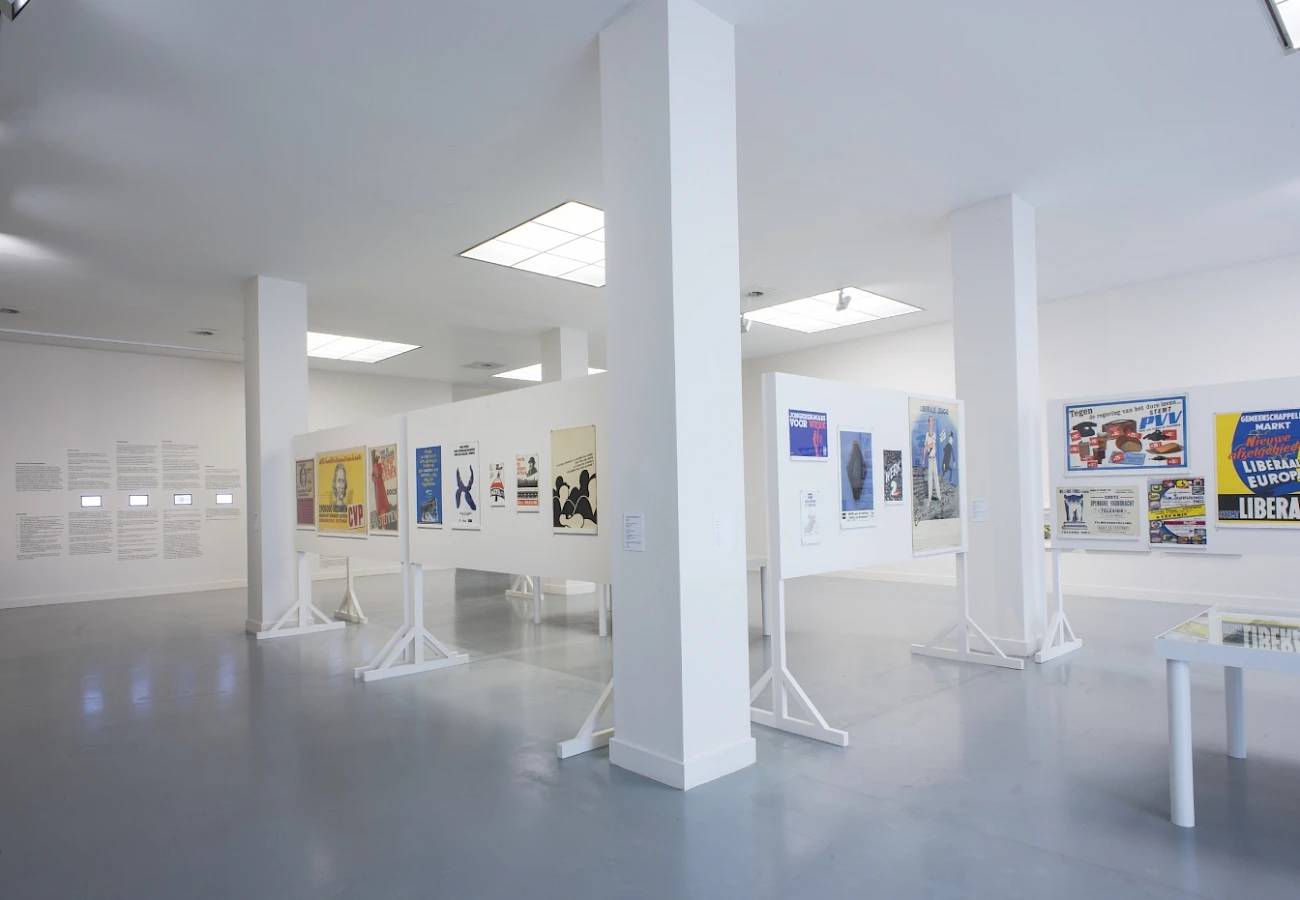
Overview of first room with posters from four Flemish archives and Arturas Raila's Libretto for Maersk Mc-Kinney Moeller, 2015. Photo by Christine Clinckx, M HKA.
The first thing visitors to The Welfare State see is a row of stands with some seventy posters commissioned by parties, trade unions and other organisations from the whole political spectrum in Belgium and Flanders, dating from the end of the Second World War until just a few years ago. The museum made its final selection from the materials offered to us by the four archives' joint working group. The topics, inspired by our problematisation of the welfare state, flow into each other, but if the visitors take the leftward route from the stand nearest to the entrance, they encounter them in this order: 'general political propaganda', 'optimism and the future', 'consumerism', 'labour and unemployment', 'women's rights', 'family policy', 'the environment', 'anti-militarism', 'solidarity with the developing world', 'immigration', 'education' and 'general social policies'. Should the visitors choose to go in the opposite direction, 'general political propaganda' will be followed by 'general social policy', and so forth. Amidst these stands are four vitrines displaying photographs selected to reflect themes such as 'education', 'housing', 'infrastructure and transport', 'holidays' and 'colonialism'. They too have been selected from the holdings of the four archives, and in addition there are photographs from the archive of the now-defunct airline Sabena (Societé Anonyme Belge d'Exploitation de la Navigation Aérienne) that were kindly lent by the Brussels Air Museum. A programme of films, and excerpts from films, again lent to the exhibition by the four archives, are shown in a small adjacent room.
Just a few words about the picture from the Belgian Congo adorning the inside jacket of this volume. We are also using it in various other contexts to symbolise and promote this exhibition. It comes from the Liberal Archive in Ghent, which holds a collection of some 2500 photographs from the Belgian Congo, donated by the family of Henri Guillaume (1914–64). From 1957 until the independence of the Congo in 1960, Guillaume headed the department for film and photography of Inforcongo, the information service of the colonial government in Léopoldville.
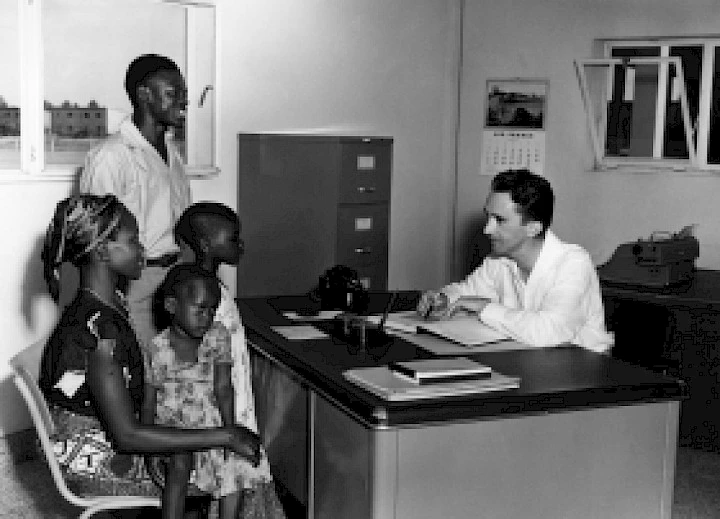
Children being registered for the official school in the community of Matete in Léopoldville. Photo by Joseph Makula, Congopresse.
This photograph was taken by Joseph Makula, the only Congolese working for Inforcongo,17 last accessed on 17 April 2015, and according to the typewritten tag on its verso it shows "children being registered for the official school in the community of Matete in Léopoldville". It was probably taken in 1958, and certainly before the riots on 4 January 1959, when protesters specially targeted the symbols (or simulacra) of the colonial welfare state in areas of the capital reserved for the évolués, the Congolese urban elite whom the Belgians considered more 'evolved'. Administrative buildings, clinics and schools were ransacked; standard-issue desks were hurled out of windows; blackboards were defaced with obscene graffiti or, worse, with subversive slogans such as Je suis indépendant.
To this day, some people seem provoked by the suggestion that the fate of the Congo could – indeed should – be discussed within the same conceptual framework as the past, present and future of the European welfare state. But how could we have found a better image than this strikingly staged composition to reflect the complexities and interdependencies signaled by our exhibition title?
